There’s a good variety of plants that I care for, and it’s not easy, but it is fun and a great learning experience. I say this because not all of them can be cared for the same way, outside of sunlight (or grow lights) and water, and even that’s being somewhat general.
I have a good set of carnivorous plants, and let’s say, depending on where you get them from, they can be expensive, but if you know how to care for them, it’s a worthwhile investment.
Here’s a list of those that I have, and the difficulties that come with caring for them. For one thing, regular (tap) water is often a no-go for most (if not all) carnivorous plants. Instead, by default, use either distilled water, rain water, or reverse osmosis water.
The most common carnivorous plant that most of us know about is the venus fly trap, and in many cases, it can be not as easy to care for. Why is it tough? It’s not the humidity, generally speaking. It often does have issues of consumption of bugs, and dormancy due to cold weather exposure. Now, venus fly traps, or VFTs for short, can survive without eating bugs, and get good sun and hydration through clean and pure water alone (see previous paragraph). One thing about VFTs, is that they cannot eat too many bugs at once, or it will begin to struggle. This is why you are often recommended to not feed the traps, either with bugs, live, dead or freeze dried, all at once, but rather one or two at a time. The nutrients will increase a spike in growth potential, and lead to new traps surfacing, while the old traps will eventually die out, which is normal.
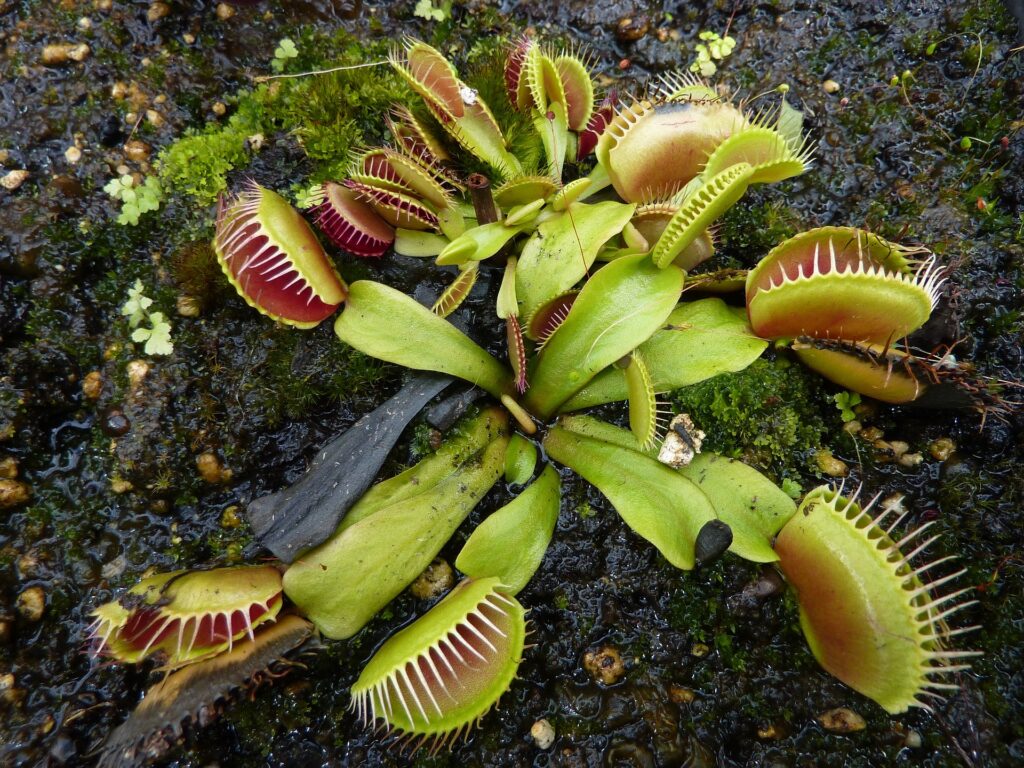
When it’s not normal, is when all of the traps, start to begin turning yellow, black or brown. That means something is not working right. If it’s yellow, it is leading to the leaf and trap it’s attached to, begin to die or is struggling. When all or most of the traps are shut due to eating bugs, it will be overworked, and some leaves will need to be cut, to reduce the work it’s doing. The ones to cut, should be the ones that are clearly the most yellow, black or brown, so that it relieves the VFT from all that work.
Not long after that, you should start to see some new traps growing. It should be maybe a week or two, before the traps should be fed again (ideally). It’s not always the case, so if you have issues with bugs, keep a close eye on the VFT, so that it does not get overwhelmed, and potentially ends up dying.
What also makes it tough to grow VFTs, is the likelihood of them going into shock, when changing environments. They need to acclimate slowly. When I say slowly, I mean weeks to a month, if you choose to repot; and I’m not referring to first arrival to potting, I’m referring to repotting, from one environment to the next. I mean a closed terrarium setting, to standard potting. The reasons revolve around the humidity changes, which may be too much for the VFT to adjust to, so it needs to go very slow in acclimation. This is true for pretty much all carnivorous plants that have this type of issue, because many are often best in humid or tropical climates, but if they are in a lower or moderate humidity situation, then they can still be okay. The problem comes where it goes back and fourth, usually when it’s from tropical to moderate or lower, it can result in these plants going into shock, and end up perishing as a result.
For most people that have VFTs, it’s often unlikely to have them for longer than a year. I’ve yet to have one to live that long, and I’ve owned overall at least between four and six, maybe more. Currently, I may have three, with one with a bit of rehabilitation, so if that doesn’t work, then the number will be two.
VFTs aren’t first ones I’ve been introduced to. However, I tried to get a few different ones, along with sundews, and nepenthes pitcher plants. I made the effort to get these all at once, but it was in the winter season, where most were supposed to go into dormancy. This didn’t lead them living that long at all.
Believe it or not, the nepenthes pitcher plants are the first ones I was able to get. The ones I got first, were the hanging pitchers, with the long basil shoots. Most cases, the pitchers can grow to about two to three inches to full size. There can be smaller traps, but that may be because of something that may be lacking, such as the humidity. More humidity will aid in getting bigger traps, and also feeding the traps will also lead to bigger overall growth of the plants.
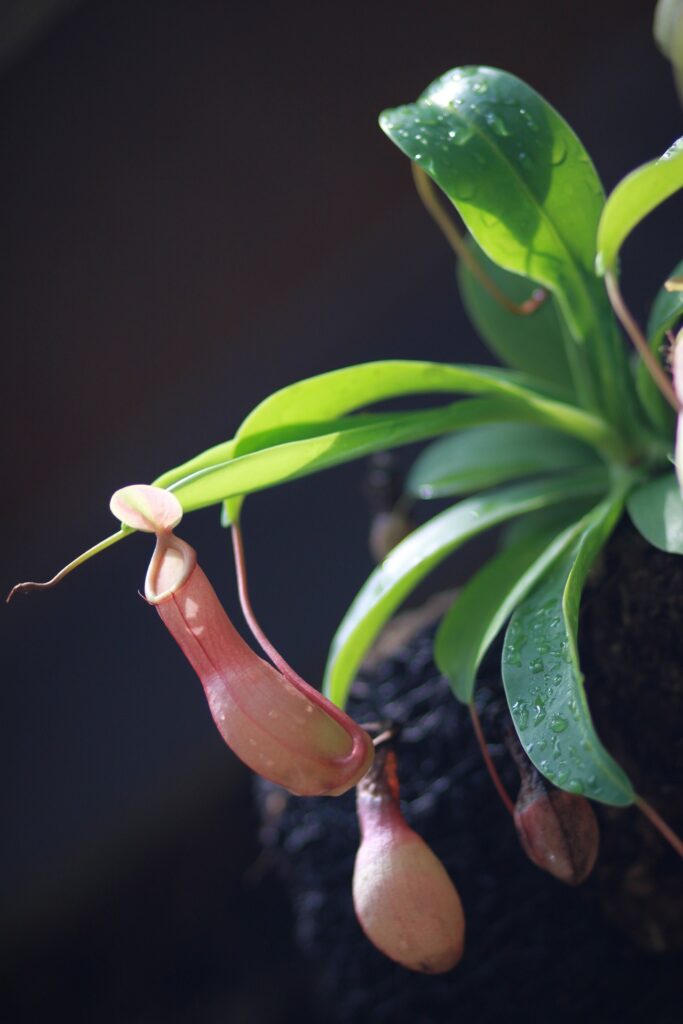
These plants can survive without making traps, and I had one particular pitcher plant that stopped making traps for well over a year, and I even propagated some from the original one that I have. Maybe around a year and a half later, some very small traps began to form. Since then I did buy one more, and after a while, I separated the plants, which led to me having two new pitcher plants, along with the ones I have prior to these new ones.
I do have a smaller variety of pitcher plant, and since I recently got this one in mid October of 2023, it will be a bit before I can say what will happen. I do know this much. I’ve used sphagnum moss to plant them in, and it’s worked well for most of my carnivorous plants.
I have another plant that’s referred to as a pitcher plant, called the sarracenia. These are quite different, and I’ve had at least two, for at least a couple of months. They seem to be growing quite well. Every so often, I will manually feed a freeze dried mealworm to a pitcher, to aid in advancing their growth. They are growing quite well right now, and under a grow light, with some sunlight during the day. The grow light is there to compensate from the changes during the day, whether it’s cloudy, rain, snow, or the transition to shorter sun exposure.
So far so good.

I’ll elude to this in a focused journal about grow lights, but I do know this much, for the sarracenia plants, there is that issue of plants becoming red due to some light stress from the grow light settings, forcing artificially this result. It happens with other plants, and it can be seen as a problem, but not in all cases. I’ll keep a good eye on these plants to see what’s happening.
As far as the sundews, they can be easy to grow, but difficult if you don’t know what you’re doing. I can attest to both instances, because of the amount that I’ve gone through so far. Why do I say this is simple? My experience was to grow them in terrariums, where initially some would grow quite well, even to the point where some would even push flower stalks. Now, I can say this, the timing of purchasing sundews does matter, because there are specific seasons where they decide to push growing flowers. That would be in the summertime. Now, under grow lights, this can happen at anytime, depending on your settings.
I’ve been able to successfully grow as of late, cape sundews, and the spoon-leaved sundews.
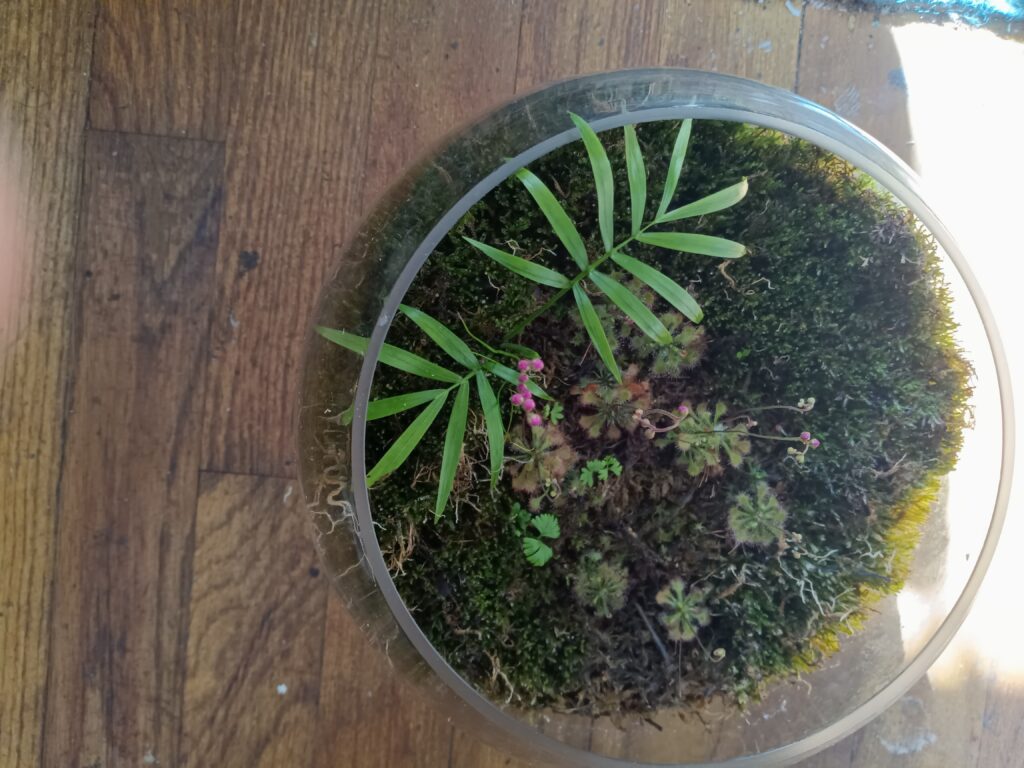
The cape sundews seem to be the easiest to grow, and I can attest to this at the moment. All I did was place them in some sphagnum moss, in a small pot, and that’s it. Leave them near a window to get sunlight, with a grow light to make up for shorter daylight, keep them hydrated, and we’re good. Had them for a few months, and I’m seeing them develop dew from the light exposure.
For these I am using grow lights because of the late fall and early to mid winter months, where natural light is less and less. For most plants, it’s required to have somewhere between 12 hours of sunlight or more, for plants to thrive. So, for this picture, they are under grow lights, just as their neighbors are experiencing.
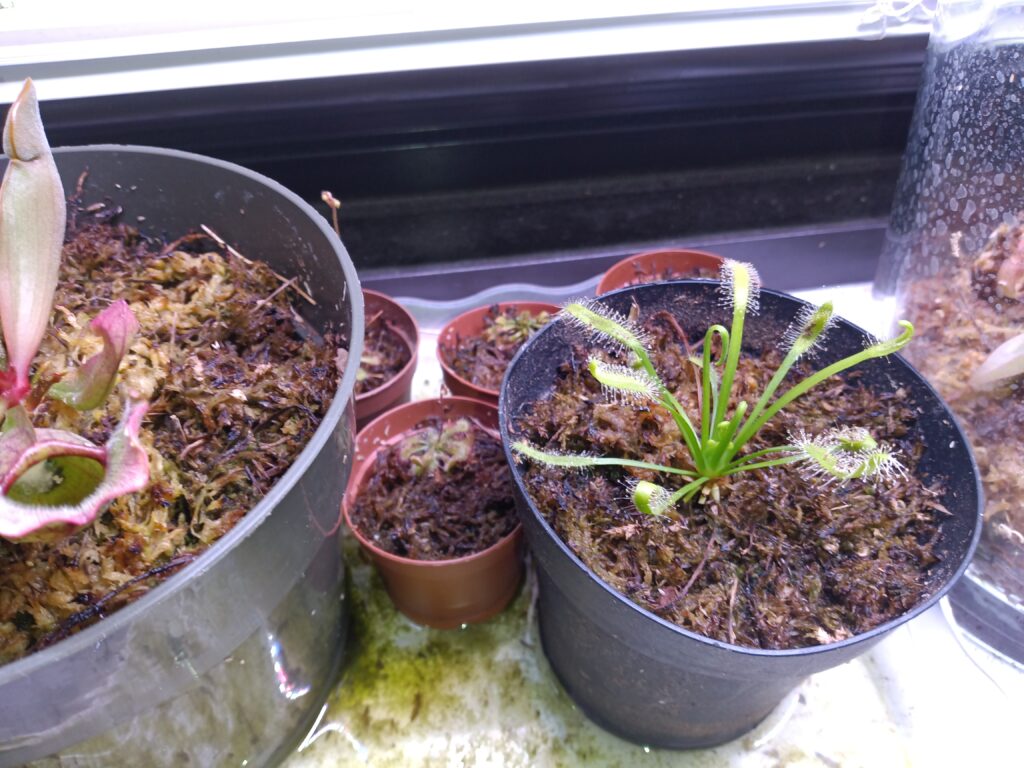
I’ve begun feeding these plants with dried bloodworms, and it turns out these are a good source for food, when these cape sundews cannot catch its own prey. By the way, the type of cape sundews do vary, and the one that most know of, are the variety that turn red and develop dew. The ones I own, are of the white form where it doesn’t turn red, but stays green, with the leaves developing dew, and appears to be white on the leaves.
So far, so good.
The spoon-leaved sundews were the ones I got first, and were tough because of me keeping them in a terrarium, but also in keeping them clustered and not separating them. At the time, I didn’t know that they needed to be separated. Every time I received a plant, like a VFT, they would often be single plants, so I went by that as a template. After a while, you figure out, for most plants to survive after you purchase them, you need to separate and then repot them. I didn’t with my first set of spoon-leaved sundews, and they pushed flower stalks, which was the reason that I knew they needed to be separated.
My second set, I separated them, and they’ve been doing quite well ever since. I also kept them in open air pots, and not closed terrarium settings. For some, I have an open air terrarium, and they are growing well. Not only are they pushing flower stalks, but they have enough space to root individually and they also are developing dew and changing from green to red. When the leaves become red, it may also produce dew and be ready to consume prey on its own. Some aren’t turning red, but they are still doing well in their growth, while also producing dew. I’ll still keep an eye out for those that haven’t done this yet, but I do know that many of them have pushed flower stalks, which may slow that dew processing down a bit.
As far as tropical plants go, there are so many, and it will take a long time to get the names of those plants. I can name a few, but often they go the route of thriving in tropical climates. Terrariums, and plants that thrive in tropical climates, are a great combination. One terrarium that I have, I call, “the tank”, is a good area for those tropical plants to grow, and has been for a good year or so. Few plants will be in distress there, because they are getting hydrated through the constant humidity, and enough light from the grow lights.
Some of the plants I can name are as follows:
Parlor palms, string of turtles, “baby’s tears”, asparagus ferns, nerve plants (green/red and green/white varieties), “creeping figs” or “creeping Jennys”, and many many others I will identify and name later. Many of them can be acclimated in moderate humidity, and still grow quite well.

There have been a few that grow quite well in, “the tank”, where some will shoot for the stars, with their growth in that environment. When that happens, it leads me to remove them, and repot them in regular pots.
I also have at least one cactus that seems to be okay for the time being. Its needles are still very white and bright, and the flesh of the cactus is bright green. It’s planted in a simple peat moss, and watered weekly, or bi-weekly. It gets a bit of sunlight, so it’s doing quite well for now. Not much else can be said, other than, so far, so good.
I can say that I’ve had a few coleus plants, both of the green with red veins, and the red with green veins. Each started off small, being in plant pots of a small enough variety to be seen as what I call “starter plants”. This is how I started with these two plants, and I did start them growing in two settings. The greener one, at a dimly lit area, light only from a west facing window, and not much to be fair. The redder one, at the south facing window, with plenty of sunlight. The redder one grew fast, where the greener one was somewhat stagnant. So, I made a change for the greener one, and brought it to the window similarly to the redder one. It began to grow just as fast, if not faster.
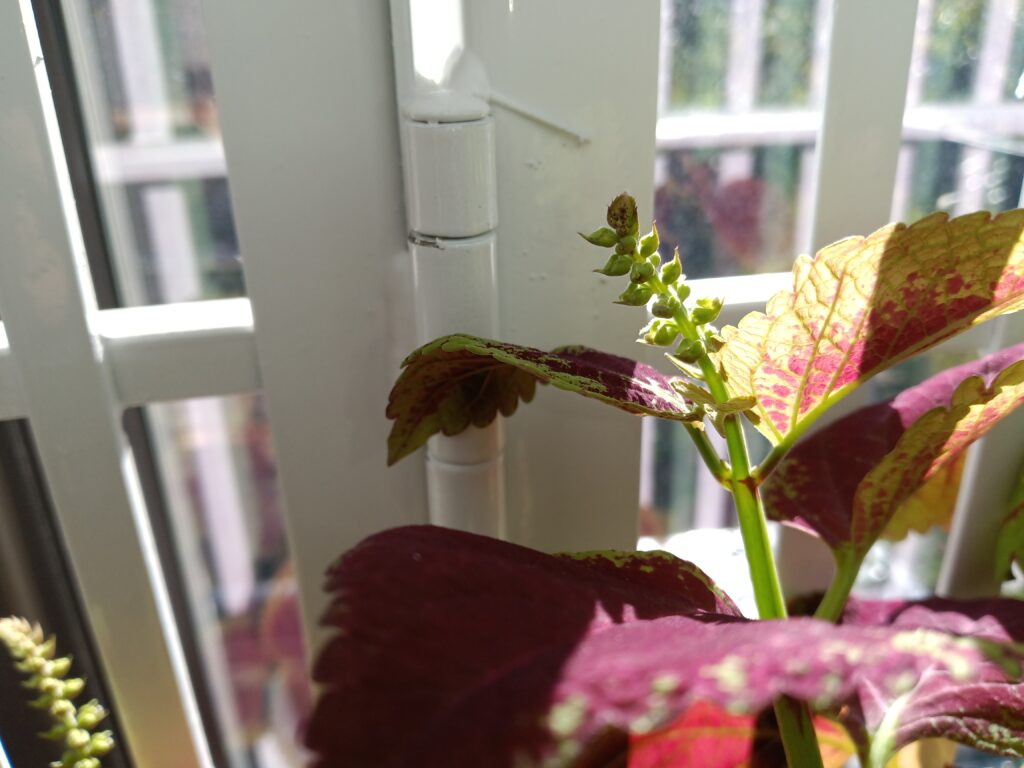
Eventually I went to transfer those to bigger pots. Then, I propagated a few from both varieties of coleus, and it led me to moving them to bigger window planters, to hold several coleus plants. Many of them since has become bushy, and some are even starting to push flowers. It’s fun to watch this, and to see how easy it was to grow them to this point. From first purchase to the flowering stage, it took maybe six months or less.
When it grows so much, it takes a lot to water them. I’ve upgraded in spraying them with a simple trigger plant sprayer, to a pump sprayer, with a high enough capacity, to cover the entire set of plants. I do this for both window planters.
I have to add this one last, and that’s the variety of moss. First should be sphagnum moss, while the other will be sheet moss that I purchased locally. The one thing about moss, is that it can dry out, but also once it’s rehydrated, it can live and even aid in being helpful to the plants they are paired with, especially when it comes to hydration. I don’t know why this is, but it’s quite helpful so see it for yourself.
Often, moss is used as a decorative addition to many other plants, especially in terrarium settings. They can be used outside of them, however, depending on the imagination of the owner, you can do quite a bit with the moss.
Many can simply pick up wild moss from nearby outdoor settings, but if that’s not available, you can find and purchase them. I got a good set, for about $10 to $15, and it wasn’t even the entirety. Some stay dry, and most of it will, because they can be a bit much, so leaving them to be dry, will be fine. You can awaken them leaving them to soak in water for a while, but leaving it in various light settings will result in lighter, and pale colored moss, or darker green colored moss.
I’ve yet to make a separate moss display, with a small, fluffy moss in a pot, which is what some specialists often do. Maybe that’ll happen later.
I have to add to this sphagnum moss, because it’s dried, but not dead, and it’s used for a variety of uses, but mostly for a different option to soil. The long fibered variety, is dried enough so that it won’t (immediately) begin to growing and sprouting new growth. That can still happen, but it takes a long time, and with the right conditions.
I’ve had some proof that this can happen, but it takes a long time. If it’s completely enclosed, no air, you’ll develop not just shoots of green leaves, but also sprouts and algae. To avoid the algae, you may need to get some springtails or other insects that will consume the algae. Since I don’t have them, I need to do something slightly different.
I’ve chosen to do this in a different container, with some fresh sphagnum moss, in hopes of getting this result, without the algae. As time progresses, I’ll update this in the next journal.
This list may grow over time, and with other follow-up journals, I’ll detail what those are, along with the plants I couldn’t identify at this time.
